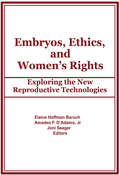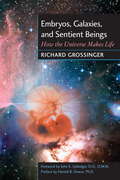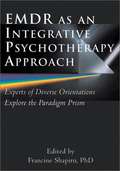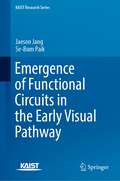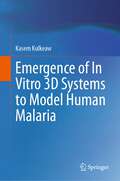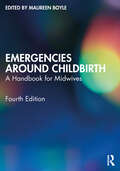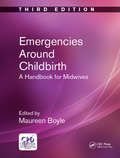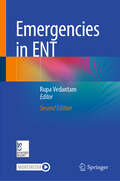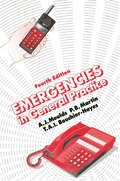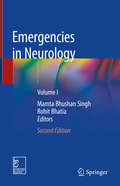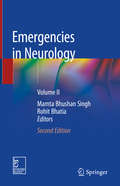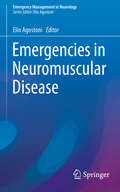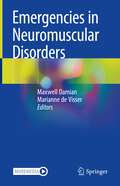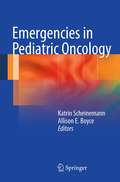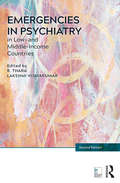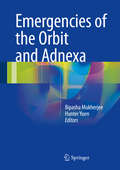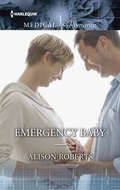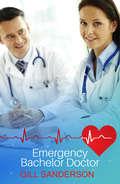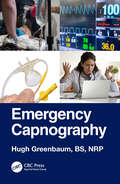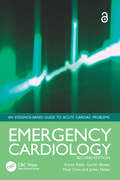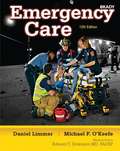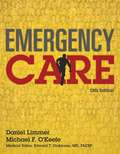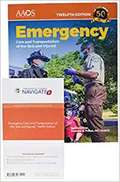- Table View
- List View
Embryos, Ethics, and Women's Rights: Exploring the New Reproductive Technologies
by Elaine Baruch Joni Seager Amadeo F D'AdamoWill procreation become just another commodity in the marketplace with “designer” sperm, ova, and embryos offered for sale? Will the attention and monies focused on the new reproductive technologies take away resources from infertility prevention, prenatal care, and adoption? If states move to regulate such practices, will this encourage widespread governmental interference in reproductive choice? How will society look at the biologically unique children who are the products of genetic manipulation--and more importantly, how will these children view themselves?This controversial book explores the answers to these questions that are frequently being asked as the battles over reproductive technologies and freedoms become more heated and touch more people’s lives. Embryos, Ethics, and Women’s Rights examines both the clinical and personal perspectives of reproductive technologies. Experts explain and debate the growing number of procreative possibilities--in vitro fertilization, genetic manipulation of embryos, embryo transfer, surrogacy, prenatal screening, and the fetus as patient. Some of the leading authorities in the field, including John Robertson, Ruth Hubbard, and Gena Corea, address the ethical, legal, religious, social, and psychological concerns that are inherent in the issues.Essential reading for every person concerned with control over basic issues of human destiny, Embryos, Ethics, and Women’s Rights provides unique and comprehensive coverage on the subject of technologically controlled childbearing and particularly its effects on mothers and their unborn children.
Embryos, Galaxies, and Sentient Beings
by John E. Upledger Richard Grossinger Harold B. DowseWhy is the universe conscious? What kindles mind inside matter? Why do fundamentalist sciences and religions never ask these questions? This sequel to Embryogenesis deals with the theoretical issues brought up by Embryogenesis, including: the relationship between thermodynamics/entropy and the emergence of life; a speculative set of embryogenic principles for all creatures on all planets in the cosmos; an explanation and critique of Intelligent Design and a proposal for a more dynamic psychospiritual theory of creature development; a series of alternatives to genetic determinism; a discussion of the relationship between consciousness and matter; an interjection of 9/11 (which occurred during the writing of this book); and many other topics. Chapters include: What is Life?: Evolution, Thermodynamics, and Complexity; Is There a Plan?: Creationism, Cultural Relativism, and Paraphysics; Biogenesis and Cosmogenesis: Cells, Genes, and Planets; The Principles of Biological Design: Physical Forces in Nature; The Dynamics of the Biosphere: Deep Time and Space; The Limits of Genetic Determinism: Dimensionless Epigenetic Landscapes; Topokinesis: Physical Forces in Development; Tissue Motifs and Body Plans: Coordinating Form; The Primordial Field: Metabiology and The Molecular Apparatus; Meaning and Destiny: The Relation of Consciousness to Matter
Emdr As An Integrative Psychotherapy Approach: Experts Of Diverse Orientations Explore The Paradigm Prism
by Francine ShapiroEMDR originator Francine Shapiro explores the latest developments and theoretical perspectives on, and clinical implications of, this complex psychotherapy approach originally developed to treat post-traumatic stress disorder. Leading spokespersons of all major schools of psychotherapy explore how EMDR meshes with their approaches, identifying the elements and outcomes salient to their world view. They offer guidelines and techniques, amply illustrated, across a range of problems and disorders, including depression, attachment disorder, social phobia, generalized anxiety disorder, body image disturbance, marital discord, and existential angst. From this diversity of viewpoints emerges a picture of similarities, differences, and strengths across disciplines and suggestions and opportunities for more robust and comprehensive treatment.
Emergence of Functional Circuits in the Early Visual Pathway (KAIST Research Series)
by Jaeson Jang Se-Bum PaikThis book discusses the emergence of diverse functional organizations in the visual pathway which could be spontaneously and solely initiated by the random feedforward wiring of neural circuits. It demonstrates that the structure of ON and OFF retinal ganglion cell (RGC) mosaics is projected onto V1 by retino-cortical feedforward mapping to induce higher cognitive functions. This book will be beneficial for both theoretical and experimental neuroscientists, as well as for researchers using brain-inspired neural network models.
Emergence of In Vitro 3D Systems to Model Human Malaria
by Kasem KulkeawThis book illustrates the importance and advances of the disease model for malaria, a globally affected public health problem. This book provides comprehensive information on the malaria biology in a liver and all in vitro platforms for liver-stage malaria, including principles, protocols, applications for disease modeling and drug screening, and their limitations. The initial chapter describes the basis of stem cells in liver generation during development and in adults. The subsequent chapters highlight recent and emerging advances in liver organoid and liver-on-a-chip in modeling malaria. The book presents current protocols and methods to generate liver organoid and liver-on-a-chip together with their advantages and limitations. Toward the end, the book examines the humanized mouse model of liver-stage malaria using ectopic artificial livers regarding novel readout modalities. The recent advancement and challenges in combining liver-on-a-chip technology with biosensors are highlighted for assessing hepatocyte development viability and functions. The book elucidates the potential of these 3D models to understand the biological complexity of cellular and molecular mechanisms involved in Plasmodium development in the liver, toolboxes to investigate parasite deployment in the 3D models, and to implement in drug discovery. Finally, the book discusses the future directions and challenges in the applications of liver organoids and liver on-chip in the biology of live-stage malaria. This book is helpful for researchers and scientists in the field of parasitology, cell biology, tissue engineering, and pharmacology.
Emergencia bajo la barrera de hielo (¡Arriba la Lectura!, Level M #16)
by Debbie Croft Christine LuitenNIMAC-sourced textbook
Emergencies Around Childbirth: A Handbook for Midwives
by Maureen BoyleSupporting readers to perform effectively in urgent or emergency situations that can occur in a hospital, at a birth centre or at home, this fully updated fourth edition presents the necessary knowledge and skills for student and practising midwives.With contributions from highly experienced midwives, this practical guidebook incorporates a new chapter on legal issues for safe practice, as well as additional content on professional issues. It also includes an essential new chapter on cardiac problems, recognising that midwives are often the lead professional caring for women with cardiac anomalies, as many are undiagnosed until the emergency. The book continues to provide key, up-to-date information on high-risk medical and obstetric situations, from serious infection to uterine complications to resuscitation.Emergencies Around Childbirth is essential reading for practising and student midwives and those who teach them.
Emergencies Around Childbirth: A Handbook for Midwives, Third Edition (Radcliffe Ser.)
by Maureen BoyleDesigned to enhance the confidence, knowledge and skills needed to perform effectively in urgent or emergency situations that can occur in a hospital, at a birth centre or at home, this fully updated third edition provides an accessible resource for all practising midwives. With contributions from highly experienced midwives, this practical handbook incorporates an all-new chapter on serious infections and continues to provide key, up-to-date information on high-risk medical and obstetric situations. It also covers relevant information on litigation and the conclusions arising from the reports from the Confidential Enquiries into Maternal Deaths. Emergencies Around Childbirth is essential reading for practising and trainee midwives, and those who teach them.
Emergencies in ENT
by Rupa VedantamThe book is a comprehensive guide to managing acute conditions in ENT. It offers a unique symptom-based approach tailored to the Indian context. The second edition includes new chapters, techniques, and enhanced illustrations. The book also contains embedded videos illustrating diagnostic techniques and surgical methods. It is a valuable resource for anyone looking to stay updated on the latest management techniques in ENT emergencies. The chapters cover critical topics such as acute epistaxis, sudden sensorineural hearing loss, acute vertigo, and complications of otitis media. Readers will also find in-depth discussions on acute facial and neck swellings, acute dysphagia, acute stridor, acute maxillofacial trauma, acute anaphylaxis and various acute postoperative complications. The authors provide systematic clinical evaluations and supportive investigations followed by commonly available treatment modes. All the contributors are actively involved in the management of cases described. This book is a must-read for its practical insights into real-world cases in secondary or tertiary care institutions. The book is ideal for undergraduates, postgraduates, fellowship trainees, and ENT surgeons in smaller hospitals or mission hospitals in remote areas of India.
Emergencies in General Practice, Fourth Edition
by A. J. Moulds P. B. Martin T. A. I. Bouchier-Hayes"This featherweight volume packs a heavyweight punch. It's a how-to guide to emergency general medical practice, which omits no important subject - the most practical book ever for general practitioners...the ideal book to keep by your side when on call." Update, 1997 Here is the fully revised fourth edition of this unique book that provides general practitioners with an easy-to-read, easy-to-use guide to the management of the vast majority of emergencies. The first contact a GP has with an emergency case is almost always a telephone call, and the advice given here by the doctor is of paramount importance in the subsequent management of the case. A unique feature of the book is that each topic begins with advice on how to handle the initial telephone call. Each presenting problem is then approached logically with concise notes on assessment, advice and management necessary when the patient is seen. The emphasis is on practical primary care, with discussion of differential diagnosis taken as far as is needed to decide the best immediate course of action. Tables are used liberally to summarise useful information.For each emergency, the ultimate advice and strategy is emphasised within heavy horizontal lines. Emergencies in General Practice is an indispensable book for the practising GP, whether in the practice, on call, or working for the co-op or deputising service. It is also a valuable teaching text for GP registrars.
Emergencies in Neurology: Volume I
by Mamta Bhushan Singh Rohit BhatiaThis is the second edition (in two volumes) of a well-received book that reflects current practices in the management of neurological emergencies. It was written bearing in mind the needs of first-contact physicians, who may be neurology trainees, neurology consultants, or interns. Special attention has been paid to various aspects of managing patients at the emergency department, from taking a good clinical history, to completing a quick and focused clinical examination, to investigating and commencing treatment. Neurological emergencies are unique in that they appear abruptly, generally follow a volatile course, and require a prompt yet balanced response. The management of neurological emergencies has been a major challenge in the past, and today, early and aggressive approaches are generally recommended. Exploring these and other aspects, the book offers a valuable asset for all practitioners seeking answers to the questions that inevitably arise while attempting to manage such critical situations.
Emergencies in Neurology: Volume II
by Mamta Bhushan Singh Rohit BhatiaThis is the second edition (in two volumes) of a well-received book that reflects current practices in the management of neurological emergencies. It was written bearing in mind the needs of first-contact physicians, who may be neurology trainees, neurology consultants, or interns. Special attention has been paid to various aspects of managing patients at the emergency department, from taking a good clinical history, to completing a quick and focused clinical examination, to investigating and commencing treatment. Neurological emergencies are unique in that they appear abruptly, generally follow a volatile course, and require a prompt yet balanced response. The management of neurological emergencies has been a major challenge in the past, and today, early and aggressive approaches are generally recommended. Exploring these and other aspects, the book offers a valuable asset for all practitioners seeking answers to the questions that inevitably arise while attempting to manage such critical situations.
Emergencies in Neuromuscular Disease
by Elio AgostoniThis book offers a practical tool for handling neuromuscular emergencies, and is divided by the main neuromuscular diseases on the basis of their anatomical and clinical location: diseases affecting the anterior horn of the spinal cord (tetanus), those that affect the nerve roots and nerves (SGB, multiple mononeuritis, porphyria), the neuromuscular junction (MG and botulism) and, lastly, muscle pathologies (rhabdomyolysis, malignant hyperthermia, periodic paralysis). It provides updated diagnostic/therapeutic protocols and decision-making algorithms for each pathology, and examines a range of scenarios on the basis of clinical cases. Emergencies in Neuromuscular Disease will be of interests for a wide variety of specialists including neurologist, neurophysiologists and anesthesiologists.
Emergencies in Neuromuscular Disorders
by Marianne De Visser Maxwell DamianThis comprehensive book addresses the acute emergencies in neuromuscular disease from a novel perspective, focusing on clinical management and treatment of these disorders rather than the more traditional neuropathology, neurogenetics, and neurophysiology approaches. The book fills the gap in guidelines by providing an evidence-based guidance for the clinical adult or pediatric neurologist confronted by an acutely ill patient in a potentially life-threatening situation. The book is structured according to pathophysiological principles, but each chapter is strictly organised around case vignettes that emphasize clinical relevance allowing the non-specialist to access complex scientific backgrounds. The electronic supplementary material and multimedia are provided as an integral tool to facilitate accessibility and understanding of a notoriously difficult field of neurology. Finally, the role of patients, who are increasingly involved in many management decisions, is highlighted in a chapter on ethical issues discussing withholding or withdrawing life-sustaining therapy, patient end-of-life values, wishes and preferences, and on advanced directives. The publication is aimed equally at the non-specialist neurologist in frontline clinical practice confronted by a rare disorder needing immediate management decisions, at the clinical specialist referring for guidance in specific management aspects, and at the specialist researcher keen to maintain clinic relevance.
Emergencies in Pediatric Oncology
by Katrin Scheinemann Allison E. BoycePediatric oncology is a considerably complex discipline requiring frequent need for reference material. Emergencies in Pediatric Oncology meets this objective by serving as a concise, practical resource for the hurried physician. Replete with diagrams and written in a clear, succinct style, this title offers an easy-to-read guide especially useful for residents, fellows, and nurses. Providing an overview of the epidemiology of childhood cancer and the history of its treatment, this title also addresses a range of key problems in the pediatric oncologic setting, covering the most common emergencies and providing short, practical guidelines on how to handle them. Written by authorities from an array of disciplines, this helpful resource provides answers and concrete guidance and is a valuable contribution to the literature in pediatric oncology.
Emergencies in Psychiatry in Low- and Middle-income Countries
by Lakshmi Vijayakumar R. TharaThere is a need to not only understand psychiatric emergencies in low- and middle-income countries but also to formulate logical and acceptable forms of intervention. This book gives the reader an overview of the kinds of psychiatric emergencies that can occur and the strategies employed to manage these in developing countries. The book covers anxiety disorders, psychotic disorders, personality disorders, substance abuse disorders, grief, suicidal behaviour and psychiatric emergencies following disasters. It also deals with special population groups, such as women, children and the elderly, who require different modes of intervention.
Emergencies of the Orbit and Adnexa
by Bipasha Mukherjee Hunter YuenThis handbook on orbital, lacrimal and eyelid emergencies deals with such situations in a practical manner guiding the ophthalmologists in accurate handling and making them more proficient and confident in managing vision and life-threatening emergencies. With 51 chapters and more than 150 images, this book covers all the eye emergencies that generalist and specialist ophthalmologists can expect to come across in their day to day practices. It can be argued that the orbit can no more be called 'Pandora's Box' because of the unpredictable nature of its contents. This perception has changed over the years due to the advent of improved diagnostic, in particular, imaging techniques. However, since medical residency provides very little exposure to orbital and adnexal disorders, most clinicians are inexperienced and unsure about their management. Facing an emergency situation where improper management can rapidly worsen the condition leading to blindness or even death of the patient is every ophthalmologist's nightmare. The emergent nature of these conditions does not always provide for a leeway to refer these patients to an orbit and oculoplasty specialist, who are few and far between. By the time the patient reaches his destination, his vision maybe irrevocably lost. The legal implications of such mismanagement can be significant too. This book is a quick and essential resource to manage and refer eye emergencies with confidence.
Emergency Airway Management
by Jerry Nolan Burtenshaw, Andrew and Benger, Jonathan and Nolan, Jerry Andrew Burtenshaw Jonathan BengerThere are few situations more challenging and stressful than airway compromise in acutely ill patients. This book concisely describes the principles of emergency airway management outside the operating room, systematically leading the reader through the components of successful practice from the principles of oxygen delivery and patient assessment to rapid sequence induction of anesthesia, tracheal intubation and the difficult and failed emergency airway. Supported by clear diagrams and algorithms, the text includes sections on a range of special circumstances and up-to-date considerations of non-invasive ventilatory support, post-intubation management and commonly used drugs. Compiled by an expert team of physicians from emergency medicine, anaesthesia and critical care, Emergency Airway Management" is an invaluable resource for trainee doctors in all acute specialties who may be called upon to manage a patient s airway in an emergency situation. It is also the official course manual of the UK Training in Emergency Airway Management (TEAM) course. "
Emergency Baby
by Alison RobertsAs part of the specialist emergency response team, paramedic Samantha Moore has always been one of the boys, but now her biological clock has kicked in and she wants a baby--fast. Samantha begins her search for the perfect father...and discovers him right under her nose--her SERT partner, Alex. She doesn't realize that Alex has had feelings for her for a long time, and when he agrees to father her child the natural way, it creates an emotional connection between them. Samantha begins to see Alex as not only the perfect father, but as the perfect husband, too.
Emergency Bachelor Doctor: A Dreamy Medical Romance (Special Care Baby Unit #3)
by Gill SandersonAnother delightful medical romance from best-selling author Gill Sanderson! Perfect for fans of Mia Faye, Laura Scott, Helen Scott Taylor, Grey's Anatomy and ER.Readers LOVE Gill's gripping medical romances!'Remarkable writer!!' 5* author review 'A truly wonderful writer' 5* author review 'I find all of Gill Sanderson's books very readable and enjoy the escapism they give me' 5* author review 'A truly gifted writer with an enormous amount of talent and sensitivity' 5* author reviewSenior House Officer Dr Kim Hunter is new to the Special Care Baby Unit at the Wolds Hospital but she takes to the work at once. It's new, it's hard but it is so rewarding.Her immediate superior is Specialist Registrar Dr Harry Black and she starts to learn from him at once. The attraction between the two moves swiftly from the professional to the personal. She loves him, thinks he loves her. But Harry is fearful of commitment and it takes Kim quite a while to understand, to help him lay the ghosts from his past.Don't miss Gill Sanderson's enthralling medical romances, including the A Lakeland Practice and the Good, Bad and Ugly series.
Emergency Capnography
by Hugh GreenbaumThis portable and practical pocket guide explains how capnography works both physiologically and electronically and helps clinical staff to apply the tool promptly and correctly, and to interpret appropriately the numeric and graphic displays, providing vital information when viewed in the context of the patient’s clinical presentation, history, and other diagnostic data that will improve and enhance care.Initial chapters explain how to interpret the data displayed in the context of various conditions, and how the care provider may respond to that data. Later chapters provide partial differential diagnoses based on the displayed capnometry data, an algorithm for interpreting waveforms, and clinical scenarios to illustrate the application of capnography in emergency medical practice.Ensuring that the value of capnography can be maximized to the benefit of patients, the book is an essential primer to capnography for those studying for and practicing within the emergency medical services, and a convenient reference for other emergency department personnel.
Emergency Cardiology
by James Nolan Neal Uren Karim Ratib Gurbir BhatiaThis fully revised and updated second edition offers practical advice on the diagnosis and management of acute cardiac conditions. Throughout the book, the authors employ an evidence-based approach to clinical practice and provide detailed guidance for day-to-day practice in a wider variety of settings-from the emergency department to intensive care and the cardiac ward. Authored by four cardiologists with extensive experience in the emergency setting, it includes the results of the most groundbreaking clinical trials. Topics include arrhythmias, acute aortic syndromes, pericarditis, and cardiac trauma.
Emergency Care (12th Edition)
by J. David Bergeron Daniel Limmer Michael F. O'Keefe Edward T. Dickinson Harvey D. Grant Robert H. Murray Jr.Emergency Care, Twelfth Edition, has set the standard for EMT training for over 30 years. Updated with the latest research and developments in emergency medical services, this edition meets the 2010 American Heart Association guidelines for CPR and ECC, providing all the practical information students need to succeed in the classroom and in the field. Using the National EMS Education Standards as a foundation, this edition goes beyond the Standards to provide the most current, accurate reflection of EMS practice today. Getting students to think like an EMT, the text integrates scientific principles in a way that's easy to understand, and a host of critical thinking features-including a new chapter, "Critical Thinking and Decision Making,"-helps students learn key concepts while getting a dose of the reality of being an EMT.
Emergency Care (Thirteenth Edition)
by J. David Bergeron Daniel Limmer Michael F. O'Keefe Edward T. Dickinson Bob Murray Harvey GrantFor courses in Emergency Medical Technician Training and Emergency Medical Services Help students think like EMTs with the gold standard for EMT training For over 30 years, Emergency Care has provided generations of EMT students with the practical information they need to succeed in the classroom and in the field. Updated with the latest research and developments in emergency medical services, this edition meets the 2010 American Heart Association guidelines for CPR and ECC. Using the National EMS Education Standards as a foundation, Emergency Care goes beyond the Standards to provide the most current, accurate reflection of EMS practice today. The text integrates scientific principles in an easy-to-understand way, with a host of critical-thinking features that help students learn to think like EMTs. Also available with MyBRADYLab(tm) This title is also available with MyBRADYLab-an online homework, tutorial, and assessment program designed to work with this text to engage students and improve results. Within its structured environment, students practice what they learn, test their understanding, and pursue a personalized study plan that helps them better absorb course material and understand difficult concepts. NOTE: You are purchasing a standalone product; MyBRADYLab does not come packaged with this content. If you would like to purchase both the physical text and MyBRADYLab, search for ISBN: 0134190750/9780134190754 Emergency Care plus MyBRADYLab with Pearson eText -- Access Card -- for Emergency Care That package includes: 0133946096 / 9780133946093 MyBRADYLab with Pearson eText -- Access Card -- for Emergency Care 0134024559 / 9780134024554 Emergency Care MyBRADYLab should only be purchased when required by an instructor.
Emergency Care And Transportation Of The Sick And Injured Essentials Package
by AaosAbout Emergency Care and Transportation of the Sick and Injured, Twelfth Edition: Since 1971, Emergency Care and Transportation of the Sick and Injured has advanced how EMS education is delivered to help train exceptional EMS professionals around the globe. Fifty years later, the Twelfth Edition is now the most advanced EMT teaching and learning system ever developed. Current State-of-the-Art Medical Content Comprehensive coverage of the National EMS Education Standards and the 2020 American Heart Association (AHA) Guidelines for Cardiopulmonary Resuscitation and Emergency Cardiovascular Care (ECC). Evidence-based medical concepts are incorporated to ensure that students and instructors have accurate, insightful interpretation of medical science as it applies to prehospital medicine today. Updated coverage of PPE and CDC guidelines for safe patient care during COVID-19 pandemic. A Focus on Career Readiness and Employability Greater emphasis on soft skill development, including empathy, teamwork, interpersonal skills, and problem solving, and how critical these skills are for better patient outcomes. Enhanced content on provider mental health, wellness, and safety. Evolving patient case studies that deliver clinical education and help prepare students to care for patients in the field. The cases offer increased focus on EMS provider leadership and critical thinking skills throughout the text. A new “Street Smarts” feature that helps bridge the gap between the classroom and field environment by addressing nontechnical skills that improve patient and co-worker interactions. A Foundation for Success The textbook design and layout have been revised to improve visualization of key content and overall readability. Comprehensive anatomy, physiology, pathophysiology, and medical terminology content is delivered in early chapters, and subsequently reinforced in related chapters throughout the textbook. Valuable student resources, including audiobook, interactive lectures, test prep, soft-skill simulations, and videos cater to a variety of learning styles and needs. Educators are supported by a broad range of instructional and assessment resources to fully enable traditional, hybrid, and flipped course delivery.
